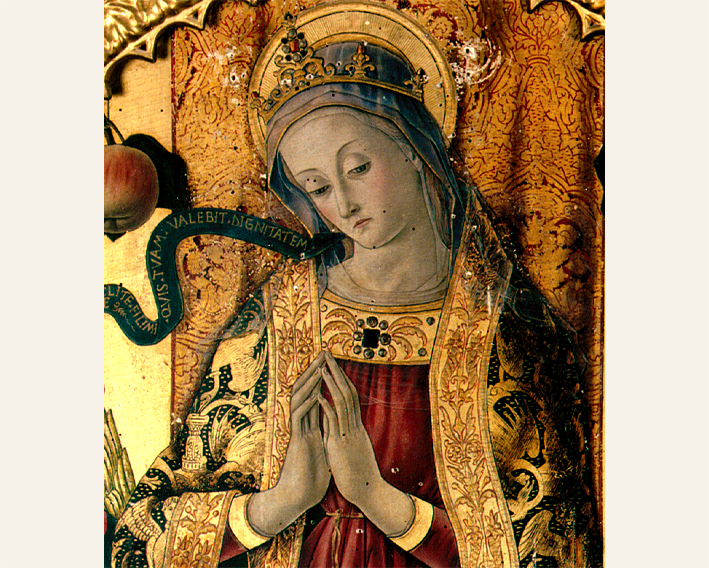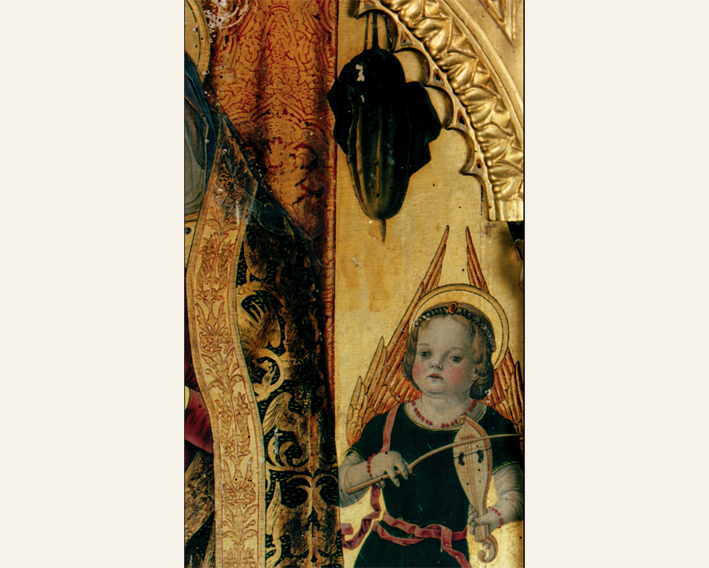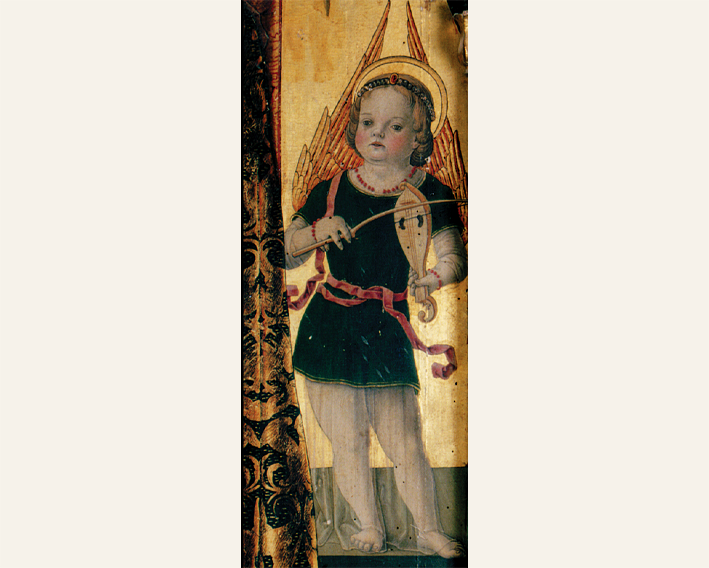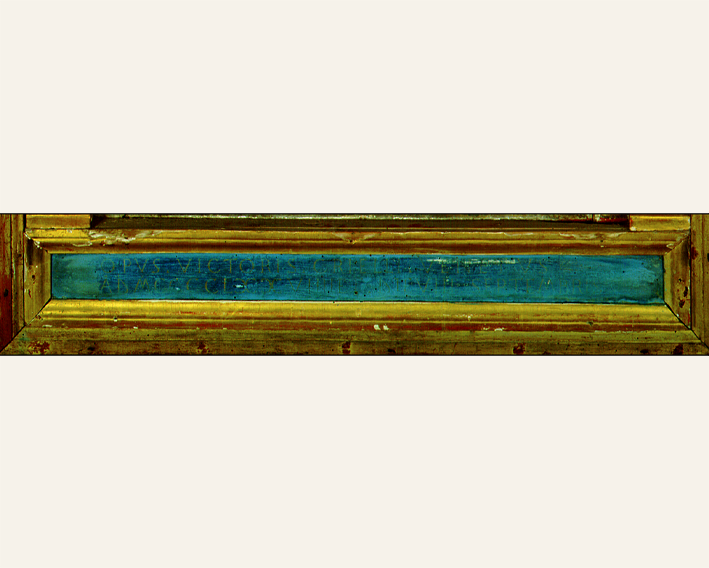Madonna Adoring the Child, Falerone
In the church of San Fortunato in Falerone, currently used as a municipal warehouse following the earthquakes, there is a Madonna adoring the Child with the inscription “OPUS VICTORIS CRIVELLI VENETURS / A. D. MCCCCLXXVIIII ET DIE VIII SEPTEMBRIS” at the bottom of the frame.
This panel is the first work created by the Venetian painter in the Marche region and appears in a document from 1484, which states that the inhabitants of Falerone prayed to this Madonna to escape a plague.
The work was then commented on during Orazio Civalli's Triennial Visit as a “Conception, by the hand of Crivello.” According to the 1727 inventory, the panel was placed on the altar of the Immaculate Conception in the church of San Francesco dei minori conventuali.
There were several attempts to read the inscriptions affixed by Vittore, by Arduino Colsanti (1905) and Laudedeo Testi (1915), but only Daniela Simoni succeeded in reading them correctly, as reported by Sandra Di Provvido in 1997. In fact, the blue scroll near the Virgin's head reads: “(V)OCA (E)OS INCLUTE FILI MI QUIS TUAM VALEBIT DIGNITATEM / (C)O(N) TEMPLARE”.
Since the earliest archival documentation, the Falerone panel has been referred to as the Immaculate Conception, although there are not many references to the Immaculate Conception. The issue was recently analyzed by Giuseppe Capriotti (2011), who points out that the only element that may allude to the Virgin's immaculacy is the decoration of the cloak that envelops her body: Vittore depicted a battle between a dragon, a bat, and a phoenix, using alternating gold leaf and dark blue pigment. This scene, which is followed by harpies, could be a representation of the cosmic struggle in the Apocalypse of John (Revelation 12:7-9).
From a stylistic point of view, the Madonna Adoring the Child can be compared to the Madonnas in the polyptychs of Torre di Palme and San Severino Marche, while it shares the antique-style decoration of the frame with the work in Sant'Elpidio a Mare.
The same scene in Falerone was painted by Vittore Crivelli for Sarnano, but much later, where it can be seen how the figures begin to recede and increasingly dominate the background.
Vittore Crivelli depicts a Madonna standing in the center of the panel with her hands clasped in prayer, intent on observing the Child lying on the ground, as is the angel to the right of the Woman.
Jesus is wrapped in a pure white sheet and lies on four cherubs, who also have blue halos on their heads. Standing upright on a marble balustrade, on either side of the Virgin, are two small angels playing musical instruments. Their wings are entirely gilded and stand out against the background, which is also painted using the gold gouache technique, i.e. applied to a red bole.
Vittore makes extensive use of brush-applied gesso on this panel: on the edges of the Virgin's dress and cloak, around the halos, to simulate stones, the crown, and on the wings of the little angel musicians. The painter uses a new technique only on this panel: he has outlined the pastiglia parts with a red pigment to make them stand out more.
Vittore Crivelli
Madonna adorante il Bambino, 1479
Tempera su tavola, 120×60 cm
Deposito comunale (già Chiesa di San Fortunato)
Piazza della Concordia, 6
Falerone (FM)
Madonna Adoring the Child, Falerone
In the church of San Fortunato in Falerone, currently used as a municipal warehouse following the earthquakes, there is a Madonna adoring the Child with the inscription “OPUS VICTORIS CRIVELLI VENETURS / A. D. MCCCCLXXVIIII ET DIE VIII SEPTEMBRIS” at the bottom of the frame.
This panel is the first work created by the Venetian painter in the Marche region and appears in a document from 1484, which states that the inhabitants of Falerone prayed to this Madonna to escape a plague.
The work was then commented on during Orazio Civalli's Triennial Visit as a “Conception, by the hand of Crivello.” According to the 1727 inventory, the panel was placed on the altar of the Immaculate Conception in the church of San Francesco dei minori conventuali.
There were several attempts to read the inscriptions affixed by Vittore, by Arduino Colsanti (1905) and Laudedeo Testi (1915), but only Daniela Simoni succeeded in reading them correctly, as reported by Sandra Di Provvido in 1997. In fact, the blue scroll near the Virgin's head reads: “(V)OCA (E)OS INCLUTE FILI MI QUIS TUAM VALEBIT DIGNITATEM / (C)O(N) TEMPLARE”.
Since the earliest archival documentation, the Falerone panel has been referred to as the Immaculate Conception, although there are not many references to the Immaculate Conception. The issue was recently analyzed by Giuseppe Capriotti (2011), who points out that the only element that may allude to the Virgin's immaculacy is the decoration of the cloak that envelops her body: Vittore depicted a battle between a dragon, a bat, and a phoenix, using alternating gold leaf and dark blue pigment. This scene, which is followed by harpies, could be a representation of the cosmic struggle in the Apocalypse of John (Revelation 12:7-9).
From a stylistic point of view, the Madonna Adoring the Child can be compared to the Madonnas in the polyptychs of Torre di Palme and San Severino Marche, while it shares the antique-style decoration of the frame with the work in Sant'Elpidio a Mare.
The same scene in Falerone was painted by Vittore Crivelli for Sarnano, but much later, where it can be seen how the figures begin to recede and increasingly dominate the background.
Vittore Crivelli depicts a Madonna standing in the center of the panel with her hands clasped in prayer, intent on observing the Child lying on the ground, as is the angel to the right of the Woman.
Jesus is wrapped in a pure white sheet and lies on four cherubs, who also have blue halos on their heads. Standing upright on a marble balustrade, on either side of the Virgin, are two small angels playing musical instruments. Their wings are entirely gilded and stand out against the background, which is also painted using the gold gouache technique, i.e. applied to a red bole.
Vittore makes extensive use of brush-applied gesso on this panel: on the edges of the Virgin's dress and cloak, around the halos, to simulate stones, the crown, and on the wings of the little angel musicians. The painter uses a new technique only on this panel: he has outlined the pastiglia parts with a red pigment to make them stand out more.









